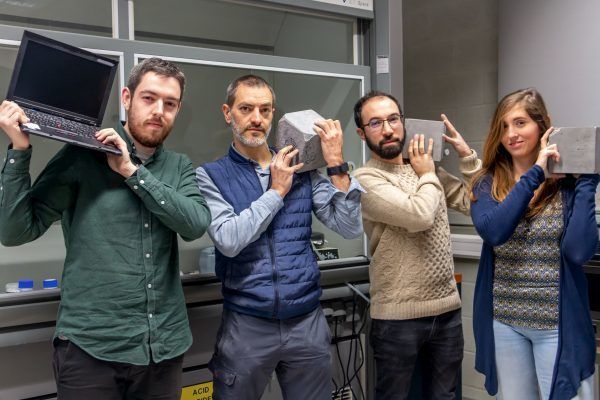THE SCIENCE OF CONCRETE THAT COULD WORK THE MIRACLE

Jorge Sánchez- Dolado (second form the left) and his team at CFM
The European Commission grants more than 3 million euros to the MIRACLE project that will be led by Jorge Sánchez Dolado, researcher at the Center for Materials Physics (CFM) in Donostia.
- The project seeks to open a window to stop global warming by using cement redesigned with nanotechnolog
The European Commission, within its FET Open program (Future Emerging Technologies), has granted more than three million euros to the research project MIRACLE (Photonic Metaconcrete with Infrared RAdiative Cooling capacity for Large Energy savings,) to design a photonic concrete with autonomous cooling capacity by radiative emission.
The project is led by the researcher Jorge S. Dolado, from the Center for Materials Physics (CFM, mixed center CSIC-UPV/EHU) and has the participation of the Public University of Navarra (UPNA), TECNALIA, the Polytechnic University of Darmstad (TU Darmstad), the Catholic University of Leuven (KU Leuven), Microligh3D, and the Polytechnic University of Turin.
In a context of increasing global warming, this scientific and technological advance can have a great impact on achieving energy-neutral buildings (Nearly Zero-Energy-Buildings) or reducing the CO2 footprint.
“With the MIRACLE project we want to “reinvent” concrete, designing it to function as a meta-material, so that it is capable of dissipating heat to outer space” points out Jorge S. Dolado.
In general, the heat emitted by any earthly material bounces off the atmosphere (the greenhouse effect), but there is a small band of frequencies by which thermal radiation can pass through the atmosphere and reach outer space. This band, called “atmospheric window” is fundamental in the technology of radiative cooling that we want to implement.
The recipe of the MIRACLE project is simple: Concretes capable of reflecting all solar radiation and emitting all thermal radiation into the atmospheric window, so that a net decrease in temperature is achieved. To do this, the composition of the cement must be modified to maximize solar reflection and to focus the radiative thermal emission on the atmospheric window by playing with the geometric arrangement of steel microfibers.
“We are fully convinced that the science and technology to be developed in the MIRACLE project opens up a new paradigm (the photonic Meta-concrete), with which “humble” materials such as concrete and cement are going to be transformed into high-tech metamaterials,” comments the research team.
While the application of radiative cooling in buildings is probably the most important application, the concept of photonic meta-concrete transcends this application. Solar cell technology, for example, requires new materials/devices to cool the solar cell configuration. Here, the challenge would be to find new concretes that combine high transparency with sunlight with high emitting capacity in the atmospheric window. Similarly, MIRACLE’s technology pays attention to the infrared (IR) region of the electromagnetic spectrum, but the concept of photonic Meta-concrete provides an exceptional basis for new applications in the field of telecommunications in other regions of the electromagnetic spectrum (e.g. technologies in the GHz and THz).




